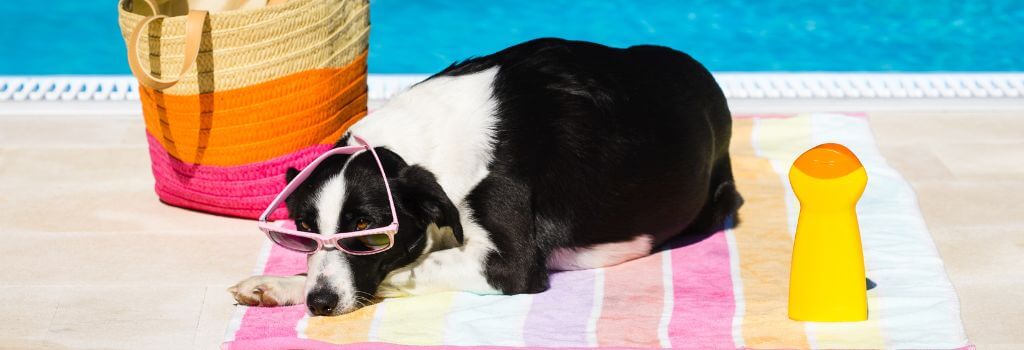For many of us, it’s a no-brainer to prioritize protecting our skin when spending time outside in the sun. But while you’re putting on your sunblock or grabbing a hat, have you ever stopped to consider if your dog is adequately protected from the sun?
Dogs are just as vulnerable to the sun’s harmful rays as people are and need sun protection, too! In this blog, we’ll share five of our best tips for protecting your dog from sunburn and teach you how to responsibly enjoy some time outdoors with your dog.
Why Sun Protection for Dogs Really Matters
While a little extra pink coloring on your dog’s belly or nose might look cute or silly, dog sunburns are no laughing matter. Just like in humans, sunburns are much more than a temporary annoyance; they can actually damage a dog’s skin and cause long-lasting – and even life-threatening – health problems.
The most common consequence of a dog sunburn is immediate pain and discomfort for the dog. Just like our own sunburns, dogs who get a little too much sun can experience blistering, swelling, tenderness, irritation, and peeling. More severe dog sunburns can even blister and form open wounds, leaving the dog not only in pain, but also at an increased risk for developing an infection. When a dog’s skin barrier is damaged by a sunburn, it becomes much easier for bacteria to make contact with their skin and enter any open wounds, cuts, scrapes, or other areas of compromised skin.
Dog sunburns can also directly increase the risk of your canine companion developing skin cancer later in life. Repeated sunburns or severe cases of sun exposure are especially risky, as sun exposure is the leading cause of skin cancer in dogs. The most common types of dog skin cancer that have been linked to exposure to UV radiation include:
- Squamous Cell Carcinoma: A very aggressive skin cancer often starting as small, crusty or ulcerated patches. Found especially on light-skinned or hairless areas.
- Hemangiosarcoma (cutaneous form): Cancer of blood vessel cells; can start on skin exposed to sunlight, particularly in thin-furred or light-colored dogs.
- Melanoma (less common): Dark pigmented tumors that may arise on sun-exposed skin, though more often seen in mouths or nail beds.
With so many health complications stemming from sun and UV exposure, prioritizing sun protection for dogs is way easier and cheaper than trying to treat infections, skin conditions, or cancer later on.
How to Protect Your Dog from Sunburn
1. Use Sunscreen for Dogs
Do dogs need sunscreen? Yes! Dog sunscreen is one of the most recommended tactics for adequate sun protection for dogs.
Just like humans have sunscreen, our dogs can use pet-safe sunscreen. Products with an SPF of at least 30 that protect against UVA and UVB rays are recommended by veterinarians to ensure effectiveness. However, not everything that’s safe for us is safe for our canine companions, so it’s best to check with your veterinarian for recommendations on dog-safe sunscreens.
Many of the sunscreens formulated for human use contain ingredients that are toxic or irritating to dogs when ingested or absorbed through any part of the body. As we all know, many dogs are avid lickers, so anything you’re applying directly to their coat or skin will need to be completely safe for them to ingest. We recommend that you avoid using human sunscreen products that contain fragrances, dyes, zinc oxide, PABA, or salicylates.
Spray sunscreens are a popular purchase on the market for pet parents, but should be used with caution, especially for owners of the wiggle butt and excited over everything breeds that we love. With spray sunscreens, it’s almost a guarantee that your curious canine will inhale them to get a good sniff, and – with all that excitement – it’s surefire they will get it in their eyes! And, of course, don’t let your dog lick the sunscreen or if you have multiple dogs… don’t let them lick each other!
For the best results with dog sunscreen, be sure to:
- Apply 15 minutes before sun exposure.
- Focus on the nose, ears, belly, tail, and any thin-coated spots.
- Reapply after swimming or every few hours outdoors.

2. Avoid Peak Sun Hours
A little extra planning can go a long way when trying to limit your dog’s exposure to the sun and intense UV rays. During the spring and summer, when temperatures are higher around the country and the days have more sunlight hours, try adjusting your dog’s schedule to avoid hours of peak UV exposure and intense sun exposure.
Plan your daily walk with your dog to be early in the morning or late evening when the sun is less intense. Provide plenty of shade when your dog is spending time outdoors, and don’t let your dog lie in direct sunlight for long.
If you live in a particularly hot area or somewhere with a lot of sun exposure, checking the daily UV index is a great habit to form so that you can assess what protection your dog might need for the day or determine if burning off some energy indoors is a better idea. Here’s a breakdown of what precautions you should take based on the UV index for your area:
- UV Index 0-2: Low risk, minimal precautions needed.
- UV Index 3-5: Moderate risk, sun protection is recommended when outdoors for extended periods or near reflective surfaces.
- UV Index 6-7: High risk, reduce time in the sun between 10 a.m. and 4 p.m. and seek shade.
- UV Index 8-10: Very high risk, take extra precautions and limit sun exposure.
- UV Index 11+: Extreme risk, avoid prolonged sun exposure and seek shade.
3. Try UV-Protective Clothing
Places now sell UV-protective dog shirts, bodysuits, and hats that can give your dog extra coverage. This is great for their belly and spots that may be balding or free of hair. There are also doggie goggles that have UV-blocking lenses. If your dog likes to dress up, likes looking cool, or is just a patient pooch, these items add an extra layer of sunburn safety.
4. Monitor Your Dog’s Time Outside
A common misconception about dogs is that they’ll come in from the sun on their own once they’re starting to overheat or if they've had enough. But that isn’t always the case.
Many dogs – especially those that love to sunbathe or spend hours outside playing – may not realize they’re overheating or getting too much sun, so it’s up to owners to monitor their dog’s time in the sun and make sure they take shade and water breaks as needed.

If your dog is spending time outside swimming or playing in the sprinklers, you’ll need to take sun protection even more seriously, as the risk increases dramatically if a dog is wet because wet fur can separate and expose the skin even more. For light-colored or short-haired dogs, 15-30 minutes in the sun while wet can be enough to cause mild sunburn, especially on the nose, ears, and belly. Dogs with thicker coats or darker skin may tolerate 30-45 minutes in the water, but they’re not immune to the increased sun exposure caused by wet fur — especially on exposed or thinly furred areas. If your dog wants to spend more time in the water on a sunny day, be sure to take frequent breaks to cool down and dry off in a shady spot.
5. Mind the Length of Your Dog’s Coat
Giving your dog a summer haircut can be a great option to help them keep cool and tangle-free, but be careful not to shave too closely if your dog spends a lot of their time outside and in the sun. While a summer shave might seem like a good idea to lower the amount of maintenance and washing your dog’s coat needs, it can actually be more harmful than helpful for some dogs.
A dog's coat provides natural protection against UV rays, and shaving it too short can actually increase the risk of sunburn. For double-coated breeds in particular, the undercoat insulates against both heat and sun exposure.
If you have any concerns about your dog’s natural protection from the sun being compromised by a haircut, talk to your veterinarian or groomer! They can make recommendations on what kind of haircut fits your dog’s lifestyle best while also giving them adequate protection from sunburns.
Don't have a vet in your area yet? We can help you find a local veterinarian.
If you have more questions, the GeniusVets Teletriage platform will give you unlimited access to text and/or video calls with board-certified veterinarians! To learn more click here.


The Ultimate Guide
to Dog Care
This free guide is an indispensable manual for dog ownership. Filled with veterinary advice and recommendations on every important topic at each stage of your dog’s life, this is all the stuff that responsible dog owners need to know. That is why we are making it free!
